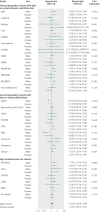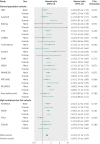Associations of estimated glomerular filtration rate and albuminuria with mortality and renal failure by sex: a meta-analysis
- PMID: 23360717
- PMCID: PMC3558410
- DOI: 10.1136/bmj.f324
Associations of estimated glomerular filtration rate and albuminuria with mortality and renal failure by sex: a meta-analysis
Abstract
Objective: To assess for the presence of a sex interaction in the associations of estimated glomerular filtration rate and albuminuria with all-cause mortality, cardiovascular mortality, and end stage renal disease.
Design: Random effects meta-analysis using pooled individual participant data.
Setting: 46 cohorts from Europe, North and South America, Asia, and Australasia.
Participants: 2,051,158 participants (54% women) from general population cohorts (n=1,861,052), high risk cohorts (n=151,494), and chronic kidney disease cohorts (n=38,612). Eligible cohorts (except chronic kidney disease cohorts) had at least 1000 participants, outcomes of either mortality or end stage renal disease of ≥ 50 events, and baseline measurements of estimated glomerular filtration rate according to the Chronic Kidney Disease Epidemiology Collaboration equation (mL/min/1.73 m(2)) and urinary albumin-creatinine ratio (mg/g).
Results: Risks of all-cause mortality and cardiovascular mortality were higher in men at all levels of estimated glomerular filtration rate and albumin-creatinine ratio. While higher risk was associated with lower estimated glomerular filtration rate and higher albumin-creatinine ratio in both sexes, the slope of the risk relationship for all-cause mortality and for cardiovascular mortality were steeper in women than in men. Compared with an estimated glomerular filtration rate of 95, the adjusted hazard ratio for all-cause mortality at estimated glomerular filtration rate 45 was 1.32 (95% CI 1.08 to 1.61) in women and 1.22 (1.00 to 1.48) in men (P(interaction)<0.01). Compared with a urinary albumin-creatinine ratio of 5, the adjusted hazard ratio for all-cause mortality at urinary albumin-creatinine ratio 30 was 1.69 (1.54 to 1.84) in women and 1.43 (1.31 to 1.57) in men (P(interaction)<0.01). Conversely, there was no evidence of a sex difference in associations of estimated glomerular filtration rate and urinary albumin-creatinine ratio with end stage renal disease risk.
Conclusions: Both sexes face increased risk of all-cause mortality, cardiovascular mortality, and end stage renal disease with lower estimated glomerular filtration rates and higher albuminuria. These findings were robust across a large global consortium.
Conflict of interest statement
Competing interests: All authors have completed the Unified Competing Interest form at
Figures




Comment in
-
Kidney disease: Does sex affect risk associations?Nat Rev Nephrol. 2013 Apr;9(4):187. doi: 10.1038/nrneph.2013.31. Epub 2013 Feb 19. Nat Rev Nephrol. 2013. PMID: 23419347 No abstract available.
References
-
- Perkovic V, Cass A, Patel AA, Suriyawongpaisal P, Barzi F, Chadban S, et al. High prevalence of chronic kidney disease in Thailand. Kidney Int 2008;73:473-9. - PubMed
-
- Wen CP, Cheng TY, Tsai MK, Chang YC, Chan HT, Tsai SP, et al. All-cause mortality attributable to chronic kidney disease: a prospective cohort study based on 462 293 adults in Taiwan. Lancet 2008;371:2173-82. - PubMed
-
- Chadban SJ, Briganti EM, Kerr PG, Dunstan DW, Welborn TA, Zimmet PZ, et al. Prevalence of kidney damage in Australian adults: The AusDiab kidney study. J Am Soc Nephrol 2003;14(7 suppl 2):S131-8. - PubMed
-
- Verhave JC, Hillege HL, Burgerhof JG, Gansevoort RT, de Zeeuw D, de Jong PE. The association between atherosclerotic risk factors and renal function in the general population. Kidney Int 2005;67:1967-73. - PubMed
Publication types
MeSH terms
Grants and funding
LinkOut - more resources
Full Text Sources
Other Literature Sources
